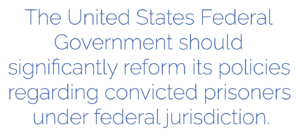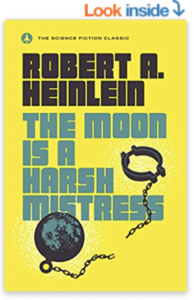Space Opportunities for Federal Prisoners

After decades of bureaucratic delay, a new space race has rocket companies like SpaceX and Blue Origin pushing costs down with reusable rockets with dramatically reduced launch costs. Soon travel to the Moon and Mars will offer business opportunities for hundreds of new enterprises and thousands of travelers.
The Moon is closer though less colorful and habitable than the Red Planet, but will be a valuable source of resources. That’s where moon mining comes in, and where convicted prisoners under federal jurisdiction could be transported as well. Prisoners facing long sentences might welcome a chance to escape their past, prison walls, and Earth’s gravity as well.
Moon mining opportunities are generally discussed outside of prison reform proposals. But that’s just because most grownups didn’t read or don’t remember Robert Heinlein’s classic sci-fi novel, The Moon is a Harsh Mistress. But the combination of lower launch costs and improved knowledge and technology might bring science fiction closer to reality.
Lunar gold rush: can Moon mining ever take off? (Mining Technology, July, 2020/March 2021):
New evidence that the Moon may be rich in metals such as iron and titanium was discovered using data from the US National Aeronautics and Space Administrations’ (NASA) Lunar Reconnaissance Orbiter (LRO) spacecraft. The scientists were looking for ice at the bottom of craters around the Moon’s north pole but found evidence of metal oxides in large craters. The hypothesis is that large meteors hitting the Moon have excavated these metal oxides from beneath the Moon’s surface – suggesting concentrations of the metal underground.

And… To save on weight, a detour to the moon is the best route to Mars (MIT News, October 14, 2015)
Who looks forward to a career in Moon mining? Not everyone of course, but maybe many with limited alternatives. Federal prisoners, for example, facing decades to life in prison are likely to find opportunities on the Moon more appealing. And if not now, then maybe after they read Robert Heinlein’s The Moon is a Harsh Mistress.
In Heinlein’s novel, prison policy draws from history where those convicted were transported away from temptation. Transportation of convicted criminal to the colony of Georgia or to Australia, or to the Moon offer opportunities for rehabilitation as well as building liberty-loving societies. Plus transported prisoners are no longer a burden on taxpayers (though perhaps a higher risk to oppressive governments).
Is it crazy to propose settlements on the Moon. Not really. Jeff Bezos and Elon Musk discussed operations on the Moon in 2017. An exclusive look at Jeff Bezos’s plan to set up Amazon-like delivery for ‘future human settlement’ of the moon (Washington Post, March 2, 2017) reports Bezo’s Blue Origin plans to to set up moon habitats by mid-2020. From separate story: Jeff Bezos says NASA should return to the Moon, and he’s ready to help, (Ars Technica, March 3, 2017).
Well, “mid-2020” has come and gone, and we are still waiting for Moon settlements (and for flying cars, inexpensive jet packs, undersea cities, and other technologies long predicted by futurists).
In 2018, the Bureau of Prisons reported that the average cost for a federal inmate was $36,299.25 per year, or $99.45 per day. A cost of $5.8 billion a year for federal prisons.
“Truth” is often up for debate. The orange image below claims $43 billion cost for state prisons and $5.8 for federal prisons. But “true cost” here is money cost or cost to taxpayers.
“Cost” for federal prisoner, listed as $36,299, but “The U.S. Census Bureau lists the annual real median personal income at $35,977 in 2019 ….”
So if federal prisoners were working and earning median US income, that would be $36,000 income per year rather than a cost (to taxpayers) of $36,300.
That’s a $72,000 a year difference! Plus if prisoners were earning income through productive work, they would more like have job skills upon release that would dramatically reduce recidivism rates.
A previous post tells the story of a free enterprise economy “breaking out” in the Maine State Prison. Economic freedom reforms would lower costs and improve life in today’s federal prisons on Earth and tomorrow’s on the Moon.
A Google search asking if sending prisoners to the Moon could really save money returns an interest alternate answer: Sending Prisoners to College Will Save You Money (Rand Blog/Newsday, April 11, 2014):
Correctional education works for prisoners, who are less likely to return to jail if they are educated while behind bars. It works for the states, because it saves money and shrinks prison populations. It works for the public, law enforcement, and the judicial system because educated prisoners are less likely to return to their criminal ways once they are released.
Because education costs are a small fraction of total imprisonment costs, every dollar invested in correctional education programs saves taxpayers, on average, five dollars. …
See also Hudson Link for Higher Education in Prison and the documentary Zero Percent. At the least, some in prison may begin researching space exploration, reading Robert Heinlein in their spare time, and launch their own Moon mining enterprise.
Elon Musk Recommends 12 Books that Changed his Life (fs.blog)
In an interview with Design and Architecture, Musk said “In terms of sci-fi books, I think Isaac Asimov is really great. I like the Foundation series, probably one of the all-time best. Robert Heinlein, obviously. I like The Moon Is a Harsh Mistress and I like Stranger in a Strange Land, although it kind of goes off the rails at the end.” He continues “There’s a good book on structural design called Structures: Or Why Things Don’t Fall Down. It is really, really good if you want a primer on structural design.”

